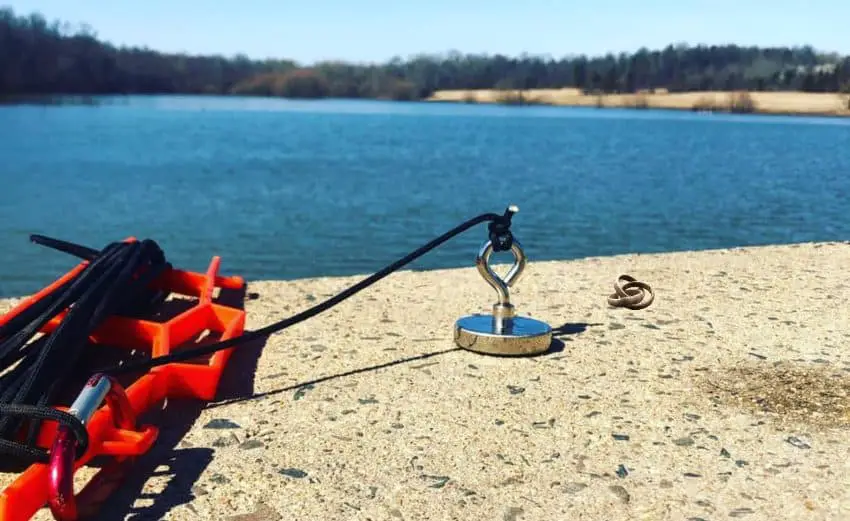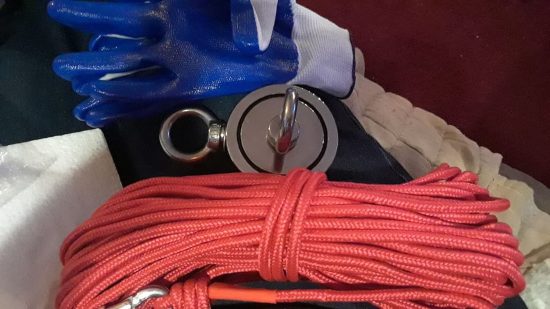
Magnet Fishing is one of those hobbies that will allow you to pick up all sorts of finds! Some of them could be just junky and some of them could be really valuable and even represent some treasure …
… One of the finds that many hobbyists are asking about is Gold! That’s a legit question by the way …
… In this Post, I address this question by providing as much details as possible.
Can a Fishing Magnet Pick up Gold?
The simple answer is no. Gold has a small amount of magnetism. Does that mean you shouldn’t fish for gold? Well, it is up to you and what your goals are.
There are circumstances when a fishing magnet can pull out gold. The circumstances are particular, but more common than you would think. But it would be best not to make a trip strictly for reeling in gold all the time.
Instead of fishing for gold, you should be fishing for the other materials combined with the gold. Jewelry is never pure gold. The other materials that make up the jewelry will lead you to valuable gold. Materials such as iron or steel make up sections of jewelry you’ll want to attract to strike gold.
What Magnet Should you use to Pick up Gold?

Since you’ll be looking for iron or steel, in theory any magnet will work to attract it. However, not just any magnet will be strong enough to hold tightly to a bracelet at the bottom of a lake. You need something with enough force not only to attract jewelry, but to hold on tight as you reel in.
A 880lbs double sided magnet will be one of your best options for pulling in any kind of jewelry. From small earrings to larger necklaces – one such as the MHDMAG Double Sided Fishing Magnet (Check it Here at Amazon) is an excellent choice for the job.
The difference between a single and a double sided magnet is the pulling force is halved with a double sided magnet.
Instead of one strong vertical pulling magnet, you get the strength halved with a double sided magnet and can cover more ground horizontally.
Covering more ground is ideal for picking up smaller pieces of jewelry. You won’t need a powerful magnet, just one that will comb the bottom to retrieve lightweight pieces.
If you have only a single magnet, that can work too. You may want to adopt a skipping technique to cover ground in sections.
It’s still very possible to pull in gold with a single magnet, and the Dakin 440lbs N52 Neodymium Magnet (Check it Here at Amazon) is another excellent choice for the job and an all around good magnet for most trips.
Is Gold Magnetic at All?
If gold is put in a magnetic field, such as when a magnet is above it, it will gain a slight amount of magnetism. However, this is only if it is in a magnetic field. And even then, it is such an insignificant amount for a fishing magnet.
To make matters worse for those planning on hunting gold with a magnet, pure gold along with other pure metals such as aluminum and silver are repelled by magnets. Which leaves lesser quality metals combined with steel or iron to be attracted only.
Fortunately, most jewelry has some type of these magnetic metals for either a backing or some type of locking mechanism. Focus on finding those types of metals and you’ll find the gold attached to them.
What would stick best to a Magnet Raw or Processed Gold?
Everyone would like to strike it rich by finding raw gold. People still visit areas where the Gold Rush took place and pan for gold. However, raw gold is not magnetic. And unless you are panning in rivers or using a metal detector set to finding gold, the odds of finding pure gold with a magnet is slim.
Processed gold on the other hand is typically blended with other materials such as iron. You won’t pull up a solid gold bar buried underwater, but you will pull up a gold necklace that is not pure gold.
A 14k gold wedding ring is another piece of jewelry you will come across while magnet fishing. The reason is because they have other “filler” metals that make up for the additional weight.
What type of Gold (18k, 14k, 10k …) Would Stick Best to a Magnet?
As previously mentioned, 14k gold pieces of jewelry are made up of filler metals. Here is a list of common jewelry terms you’ll find useful:
- 24k is 100% gold.
- 18k is 75% gold.
- 14k is 58.5% gold.
- 10k is 41.7% gold.
As you can tell, 10k would be the most magnetic. Is it the most ideal piece of jewelry, not necessarily! But treasure is treasure.
Ideas on identifying Gold Finds …
The best way to identify gold is by the markings on the piece, if available.
- 24k is stamped with 999.
- 18k is stamped with 750.
- 14k is stamped with 585.
- 10k is stamped with 417.
Inspect each find thoroughly because the stampings could be worn away or difficult to find. Search for any kind of markings on the piece because the item could also be gold plated.
Gold plating is a thin layer of gold over another type of metal. Without any kind of markings, it will be difficult to determine what type of gold plating, if any at all, is on the piece of jewelry.
If you are fortunate enough to find any type of marking, a quick search online will help determine its meaning. Without any kind of marking, you will not be able to easily pinpoint the exact type of gold you have.
Another tried and true method of spotting fake gold involves using your fishing magnet. Does it attract the magnet? If yes, then you do not have 24k gold.
Ideas on Cleaning, preserving Gold Finds …
What should you do with all your gold finds to clean and preserve them? Believe it or not soap and water is one of the ways to clean your new found treasure.
You’ll want to use a mild dishwashing soap and avoid using any type of hard bristle brushes. Especially when handling 24k gold. The reason for this is because 24k is easily scratchable.
A quick way to clean up gold is with a small bowl of warm water, a few drops of dish soap, a few drops of ammonia, and a baby-size soft toothbrush. Mix your three ingredients together and gently scrub your gold.
For tough, stuck on dirt it is best to leave the jewelry in solution for a few minutes prior to scrubbing. It will help break up the dirt making it easier, and safer to scrub away.
You can air dry or pat down with a paper towel after cleaning. Remember, gold is a soft metal that can damage easily.
This method is one of the safest you can use to clean your finds. But it’s worth mentioning that the soap you use is important. Avoid soaps with unknown ingredients. The same can be said about chlorine and hot water.
Chlorine and hot water are a surefire way to tarnish your gold. Along with some ingredients found in some soaps.
Dawn dish soap is recommended.
So, once you get all the dirt and grime off your gold finds, you should consider taking your cleaning to the next level with chemicals. Don’t worry, jewelry cleaning chemicals are specially formulated for cleaning gold with soft chemicals.
A quick dip in commercially available jewelry cleaner will help remove the tarnish built up on your gold. Simple Shine is specifically formulated for cleaning jewelry while being safe yet effective on tough stains.
Similar to the first method, you simply dip the gold in the solution (Check it Here at Amazon), scrub, dip again, then pat dry with a paper towel.
The final method is to take your finds to a jeweler for professional cleaning. This method is for items you suspect might be of high value or you want someone with professional cleaning machinery to get the job done.
Some major retail jewelers will clean your jewelry for free or for a small fee.
After your gold is clean, you need to preserve it and to do so you’ll need proper storage. Not just thrown in a jewelry box loose. Each item needs ample amount of space not to rub against other pieces of jewelry.
You want to protect the integrity of your finds, and a proper jewelry box with dedicated space is ideal.
Bracelets and necklaces are known for tangling in on themselves. You’ll definitely want to invest in a stand that can hang them so they stay perfectly vertical.
Once a necklace becomes tangled it can become difficult to work out all the knots. Lower quality necklaces might even break during the untangling process. Avoid the headache and hang your chains properly.
As for rings, either keep them in separate compartments or find a box with ridges that can rings in place.
What about other metals like Silver … ?
All this talk about gold, yet other precious metals such as silver are also available in bodies of water. Let’s cover some other popular metals you’ll come across during your next fishing trip.
1. Silver
Silver is one step below gold in value, and just like gold it is not magnetic. However, silver plated items would be magnetic. You won’t find pure silver sitting at the bottom of a lake, but silver is hardly ever alone.
Just like gold, you’ll attract the materials combined with silver, such as a steel locking mechanism to a silver chain.
Everything about gold is the same for silver except for silver is less valuable.
2. Copper
Everywhere you look copper is in abundance and unfortunately, copper is not magnetic enough to pick up with a magnet. The magnetic force of copper is too weak to successfully reel in any.
Under extreme circumstances, such as really powerful magnets like the ones used in power plants then in that case copper is magnetic. In fact, this type of magnetism can generate electricity.
However, in practical terms, copper is not magnetic enough for your fishing magnet.
3. Iron
In the case of most of the gold you attract with a magnet, it is because of the iron content that allows it to be picked up.
Iron is magnetic and besides steel, it will be one of the most common metals you come across when you are out magnet fishing.
Speaking of iron and steel, when visiting places such as fishing piers, the construction will be made out of either material and you can easily get stuck on a pillar. You might encounter these pillars more than other items in the water.
Do not let them discourage you, instead pick up a grappling hook or if you can reach, a flathead screwdriver to pry off the magnet.
Conclusion
Hope this Post has given you all the information and excitement to get started into this hobby and hopefully hunt for some Gold …
… The latter is not that frequent, yet it is totally possible to find it if you consistently try!
Finally, I just finished writting this Magnet Fishing Resource for Beginners! Check it out … I include everything you need to know there!
